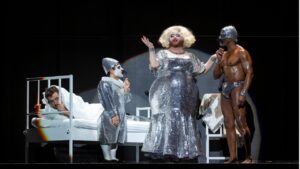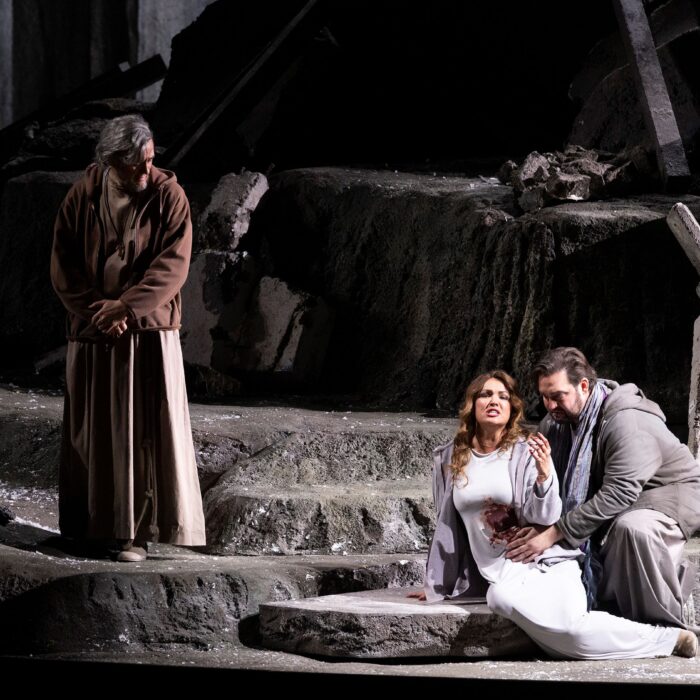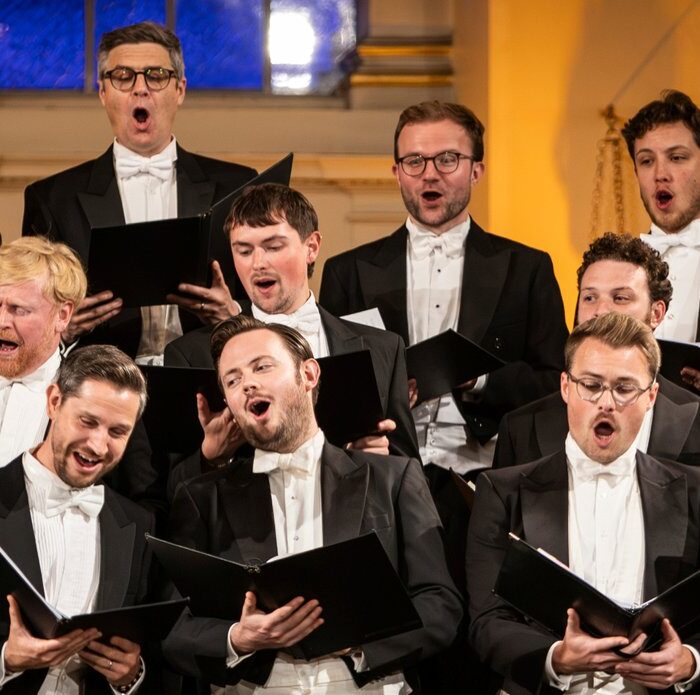
Opéra National de Paris 2024-25 Review: The Rake’s Progress
Olivier Py’s Production & Susanna Mälkki’s Musical Direction Revive Stravinsky’s Masterpiece
By João Marcos Copertino(Photo: Guergana Damianova)
There is a question that has tormented opera fanatics for at least a century: how can opera go on? What sound represents the future of opera? While many, especially in the mid-20th century, leaned toward musicality that was either dramatically disruptive or staunchly conservative, Stravinsky forged a career where he managed to be both. In a world where originality is both central and commodified, few works resonate as disruptively as Stravinsky, Auden, and Kallman’s “The Rake’s Progress.”
The opera sits somewhere between a parody and an elegy for classical musical conventions—a clear masterpiece. The sensibility, ethereality, and cunningness of “The Rake’s Progress” are even more pronounced in the revival of Olivier Py’s excellent production, under the extraordinary musical direction of Susanna Mälkki (a reigning authority on the 20th-century repertoire).
Illuminating Production
Py, a must-see director of French theater, infuses his stagings with a clear signature. While author-directors often have their ups and downs, I have yet to see a Py production I did not like. That said, his works frequently bear a certain sameness, and “Rake’s” is no exception: the dark scenery, set in a vaguely specified past (somewhere between the 1850s and 1970s), fluorescent hospital lights, and cabaret-style nudity—all his hallmarks were on display at Garnier last night, and they all worked. They worked because Py is an aesthete of the stage, and they amplified the allegorical power within “Rake’s” libretto.
If I understood anything from Walter Benjamin’s “The Origin of German Tragic Drama,” it is that allegorical theater gains strength during times of capitalist modernity. Allegory reminds people that things can still be simple, especially as they become fragmented, commodified, and desacralized. Stravinsky’s decision to return to allegorical theater through his reading of William Hogarth’s series of allegorical paintings—is in perfect dialogue with this power: it shows a world where things are just as they are, where right is right, wrong is wrong, and goodness exists inexplicably, for its own sake. Py’s staging does not negate this vision but instead enhances it, replacing common 18th-century aesthetics with more elegant and abstract ones. Even small additions to the stage—like a motherhood narrative for Anne Trulove—serve to reinforce the moralizing power of allegory. The only character who might have any psychological depth is Tom Rakewell; all the others are intentionally simple, representing good or bad without ambiguity.
Gold Schultz’s Stunning Performance
There is immense charm in the portrayal of shallow characters: their actions on stage define who they are, without hesitation or doubt. In this regard, no one embodies this better in the opera than Golda Schultz. Rarely has a singer impressed me more. Not only is Schultz an exceptional vocalist who brings out the best in Anne Trulove’s beautiful arias and coloraturas, but also she makes us fully believe Anne is exactly as she sings—nothing more, nothing less. While some sopranos look for signs of interiority in the character—by nuancing their enunciation of certain words or adding subtle dynamics—Schultz sings everything with immense precision and determination. There is nothing within her character that she is undetermined to show.
Her high notes are as unwavering as the sky is blue (the end of “I go to him”! – O. M. G.). Beyond that, her voice and stage presence make it easy to fall in love with her performance. Her rounded, richly colored voice perfectly matches Trulove’s appeal, as if she were Stravinsky’s revenge against all Mozart & Da Ponte’s deranged women: here is their female ideal.
More Cast Details
Tom Rakewell, the womanizer, on the other hand, is a trickier character. Ben Bliss is no stranger to the role, but I felt like his portrayal is still a work in progress. What exactly is missing is hard to pinpoint. He has the voice and the looks for Rakewell, but a certain panache is lacking—especially for a rake. This became evident to me when he sang his first aria “Here I stand… Since it is not by merit”: all the words and intentions were there, but in the higher range, there was an audible effort in his singing. It was as if we could hear his body producing the sound rather than simply hearing the sound itself. Such a vocal quality is not inherently bad—it can work depending on the role—but here it empties Rakewell of his charismatic tricksterhood.
Perhaps due to my difficulty understanding Scottish accents, I struggled somewhat to follow Iain Paterson’s delivery of the English text—I needed no subtitles for the other singers or the chorus. Paterson, who has built his reputation singing Wagnerian roles, nevertheless demonstrates how commanding his instrument can be in 20th-century music. He is a solid singer and occasionally a compelling actor, but for such a chilling role as Nick Shadow, something felt amiss. Even in the vocal thrills of the third act lacked focus (especially in the longer vowels) and intonation.
Few roles in opera are as charismatic as Baba the Turk, and Jamie Barton combines that charisma with her immense charm—seriously, is there any singer who gets so much good will from the audience as she does? Beyond her impressive instrument—with its remarkable resonance in the Garnier hall—Barton graciously ballets onto the stage, sporting her thick beard as if she were the opera’s true protagonist (Stravinsky just happened to forget that). Her stage magnetism was such that I felt the second act should have ended with her entrance. It was one of those operatic moments that demanded a cut, as if nothing could follow the grandeur of her voice in the hall, climbing the stairs alongside Bliss, wearing a glittery gown I’d wear to the Oscars if I were invited.
Clive Bayley performs capably as the English patriarch Trulove, commanding the role with authority. The rest of the cast also offers strong performances, particularly Justina Gringyté as a sexualized version of Mother Goose.
Susanna Mälkki Gives Impressive Interpretation
Finally, another star of the evening was Susanna Mälkki’s interpretation of Stravinsky’s score. Mälkki is one of my “go-to” conductors for 20th-century repertoire. I have heard her conduct the most amazing Debussy more than a few times. However, I think that her reading of “Rake’s” is, by itself, one of the great achievements of musicianship in this century (one is given to superlatives when full of joy after a great performance). If I was already mesmerized by it when she conducted it at the Met, I now feel like an evangelist of the gospel of Stravinsky according to Susanna Mälkki. While many great conductors have recorded this opera with brio, Mälkki captures the ethereality of Stravinsky’s neoclassical phase with unmatched elegance and control, particularly from the woodwinds. While the characters are allegorical, the orchestra is extremely hard to understand. The sounds are so sublime that one cannot help delighting in them over and over again—and still, is it all pretending? Is the orchestra just joking with us? I would be eager to hear Mälkki conducting pieces such as Stravinsky’s Mass, which shares a similar musical realm. The results she achieved with the now-exuberant Paris Opera are deserving of a good studio recording (if Classical music had this kind of money…).
I really, really, enjoyed myself watching Paris Opera’s “The Rake’s Progress.” Despite some reservations, it remains a highlight of my season. Py’s revival feels fresh and new, and the cast—even with its weaker links—is of a superior level. It is a triumph. I loved it so much that I am doing something I usually cannot afford: returning to the opera house again and again, spending money I do not have, just to experience such theatrical beauty once again.
Categories
Reviews

